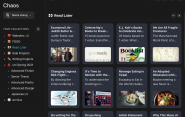Overwhelmed by Bookmarks? Don't Worry, Here's Chaos

Modern technology makes it easy to browse the web, make bookmarks, and take notes. So easy, in fact, that all of these bookmarks and notes can accumulate into an unmanageable mess. Fortunately, though, we now have Chaos, a new bookmarking app that lets users save anything from the web, along with local images and documents. It was created by CEID Design Fellow Sarim Abbas ’20.

Abbas, who recently launched the app, began Chaos as a senior thesis with Prof. Ruzica Piskac and graduate student Mark Santolucito (who has since received his PhD) as his advisors. It’s now available for download here: https://makechaos.app
“I was thinking about what I wanted to build, and the one area I looked at was organization,” he said. “I was very interested in the idea of bringing everything together in one place.”
There were other organizational apps out there, but Abbas wanted to develop a more experimental software that forged its own path. Specifically, he wanted a better way for users to bring together their unique fragments of the internet into a coherent whole.

“If you save something in Chrome, it can get lost and you can’t really find where you put it, because it’s all text,” said Abbas, who will be leaving his post at the CEID later this week - he’s heading to the Bay Area to work with start-up Neeva, which is developing a privacy-focused search engine. “Chaos gives you a rich preview of everything with better organizational controls. So instead of hunting around for that website you saved, you can instead search for it and it’s much easier to work with.”
While Chaos helps with saving things, it’s the organizational aspect that distinguishes it. Instead of keeping a long list of bookmarks, it has a folder system that lets users store things in an infinitely deep information tree and search anywhere along the tree. You can also pull multiple websites together and open them side-by-side, which can be useful to anyone who wants to take notes and look at research at the same time.
Abbas’ original intent was to create something that would allow users to store things offline. But while building Chaos, Abbas talked to Prof. Piskac and Santolucito, fellow students, and people in Yale’s Digital Humanities program about what they wanted in an app. He then switched to building something more cloud-based. “The more interviews I’ve done, the more it’s changed,” he said.

Abbas refined the app while working at the CEID, during the “self-development time” that comes with the position. Abbas said that this time, plus the guidance he received from CEID’s director Deputy Dean Vince Wilczynski, were vital to completing Chaos.
“He and everyone else at the CEID – Joe Zinter, Larry Wilen, and Antonio Medina – were really supportive of my work there,” he said.
Besides his computer programming skills, Abbas also looked to some of the design philosophies he studied while a student at Yale. Specifically, he optimized it for different platform and screen sizes by conducting usability tests. He also drew from Dieter Ram’s 10 principles, which he learned from the CEID course ENAS400: Making It. While building Chaos, he wanted to avoid some of the dark patterns of similar technologies.
“A lot of software today encourages certain behaviors, where they keep you coming back over and over, so you’re the product in addition to using the product,” he said. “Here, I wanted it to be a mutually beneficial relationship where the user gets as much out of Chaos as they put in. I think ‘design’ is a catchall term for how things should not only look and behave, but also respect the person who’s using them.”

